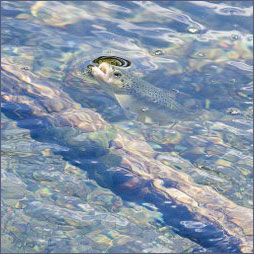Basic Facts about Tricos
|
A brown trout taking a Trico spinner. |
Tricos are a small mayfly of the Tricorythodes genus that hatch in prolific numbers from July - October. The duns are a pale gray/olive in color with light gray wings and hatch either in late evening or early morning. Spinners fall in the morning when the air temperature hits 68 degrees F. The sheer numbers of the hatch as well as the long duration (upwards of three months) makes them a very important food source for the most finicky trout. Although the flies are small, size 20-24, the fishing is relatively easy because the fish rise regularly and lose some of their usual caution as they get preoccupied with the vast amount of food available to them. Rises are subtle but deliberate, and often the trout make a smacking sound then they eat the spinners. During a heavy spinner fall the trout will "gulp" the spinners, or make several rises at a time, followed by a short pause as they swallow the insects.
The ability to drift such a small fly without drag takes skill and very fine tippet, 6x and 7x. However, fish feeding on Tricos will sometimes eat a larger fly like an ant or beetle, so if fishing these tiny flies get frustrating try a size 14 ant or size 16 beetle. One of the best things about a morning Trico spinner fall is that the fish seem to look to the surface for food for the rest of the day, so fishing ants and beetles (or sunken imitations of drowned Trico spinners) can provide great fishing all day long.
Tom Rosenbauer's Favorite Trico Patterns
|
Down Deep Trico: Tricos can be maddening due to their size and the often ridiculous selectivity of the fish. Often the spinner fall is easier to fish as trico spinners are either dead or dying and easy targets. Many times they are just under the surface and the trout are less wary when feeding. A drag free presentation is critical and this pattern is an excellent representation of a trico spinner with a long tail, slender abdomen and thick thorax. |
 |
| Indicator Parachute: The Trico hatch can be one of the most prolific feeding periods you will experience, but they are very difficult to see, the fish can be picky and it can be maddening. This indicator pattern sets your fly out from the rest so you can see it and yet has the realism necessary to be successful. |  |
| Cannon's Bunny Dun: Jim Cannon of Blue Quill Angler in Evergreen, Colorado has been in the business for many years. This excellent pattern in a number of species and sizes uses a rabbit fur wing for durability, visibility and great floatation. This is a very proven pattern and one you shouldn't be without. |  |
| Krystal Spinner: A very realistic pattern for mayflies and tricos using a very translucent wing material that closely resembles the real thing. Even offers the male and female trico spinners which are substantially different. |  |
| Rosenbauer's Parachute Beetle: I don’t care if you pick my beetle or another beetle pattern, just don’t go on a trout stream without one during the summer. In some rivers, especially on smaller streams, up to 80% of a trout’s summer diet is terrestrial insects—and much of that is beetles. Try a size 14 first, and if that doesn’t work, go next with a 16 or 18. Beetles are also great strike indicators to use with small nymphs. |  |
| Travis Para-Ant: Ants are the most common terrestrial on the water. They are found everywhere and fish know what they are and love to eat them. From the vise of Tom Travis of Livingston, Montana comes this high visibility parachute ant pattern that will work well into the evening hours of last light. |  |
| General T: A fine sparkle wing caddis adult. Very lifelike imitation with just enough sparkle to add a little attraction. Try skating this one for some real fun. One of the better caddis patterns we've seen. |  |





